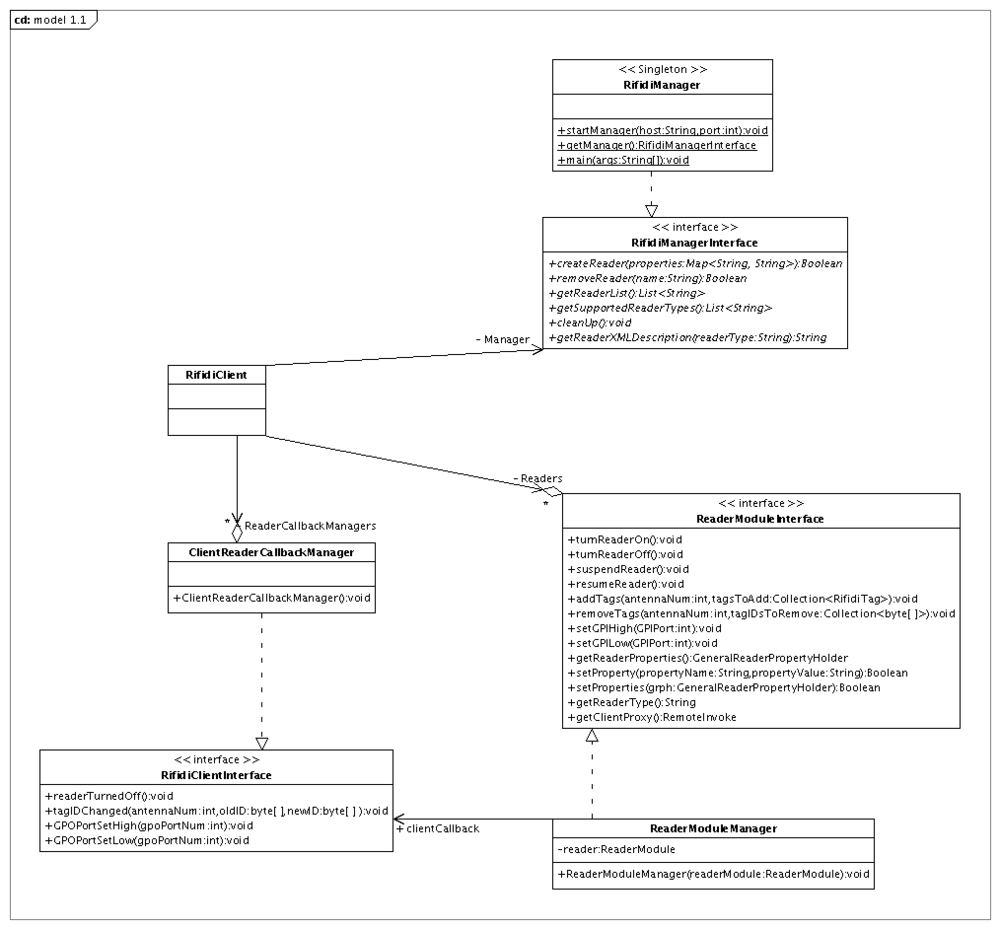Difference between revisions of "Engine RMI Interface"
From RifidiWiki
(→Architecture Components) |
|||
| Line 12: | Line 12: | ||
One important aspect of this architecture is that The client doesn't care if a Reader Server is local or remote. That fact is transparent to the client. | One important aspect of this architecture is that The client doesn't care if a Reader Server is local or remote. That fact is transparent to the client. | ||
| − | =Class Diagram= | + | =Rifidi RMI Implementation= |
| + | This section describes how RMI is implemented in Rifidi. | ||
| + | ==Using Cajo== | ||
| + | Cajo is "a small, free library, enabling powerful dynamic multi-machine cooperation; both within and between, both free and proprietary Java applications. It provides a surprisingly easy to use, yet completely understandable framework to dramatically simplify the use of RMI; whilst at the same time harnessing its full potential." | ||
| + | ===Remote Interfaces=== | ||
| + | ===Callbacks=== | ||
| + | ==Class Diagram== | ||
[[Image:RMI_Class_Diagram.png|thumb|1000px|none|A UML Class Diagram depicting the components of the RMI Architecture in Rifidi]] | [[Image:RMI_Class_Diagram.png|thumb|1000px|none|A UML Class Diagram depicting the components of the RMI Architecture in Rifidi]] | ||
| + | ==RMI in action: An example== | ||
=Reference Client= | =Reference Client= | ||
Revision as of 19:07, 23 November 2007
RMI (Remote Method Invocation) is an architecture that allows clients to invoke methods on remote machines. Rifidi uses this architecture to allow the IDE (and the Tag Streamer) to communicate with the reader. It uses the cajo library to provide the RMI functionality.
Contents
Purpose of RMI Architecture
The basic goal of implementing RMI in Rifidi is so that one client (i.e. the IDE or Tag Streamer) can transparently control multiple readers on different machines, if need be. This enables a distributed architecture that will allow rifidi to drive performance testing of edge servers, because multiple machines can run rifidi readers, thus distributing the load across a network of computer. At the same time, however, it should be easy to start up one or two readers on a local machine for compatibility testing or to simply experiment with a reader.
Architecture Diagram
Architecture Components
- Client The client (such as the IDE, Tag Streamer, or Designer) runs on a local machine. Its purpose is to allow the user to manipulate readers (i.e. start, stop, add tags, etc).
- Reader Server The Reader Server manages one or more readers on a particular machine by creating and destroying readers. There is one instance of a reader manager per machine.
- Reader A reader is the program that emulates a particular reader, such as an LLRP Reader. There can be multiple instances of a reader on a single machine.
One important aspect of this architecture is that The client doesn't care if a Reader Server is local or remote. That fact is transparent to the client.
Rifidi RMI Implementation
This section describes how RMI is implemented in Rifidi.
Using Cajo
Cajo is "a small, free library, enabling powerful dynamic multi-machine cooperation; both within and between, both free and proprietary Java applications. It provides a surprisingly easy to use, yet completely understandable framework to dramatically simplify the use of RMI; whilst at the same time harnessing its full potential."

